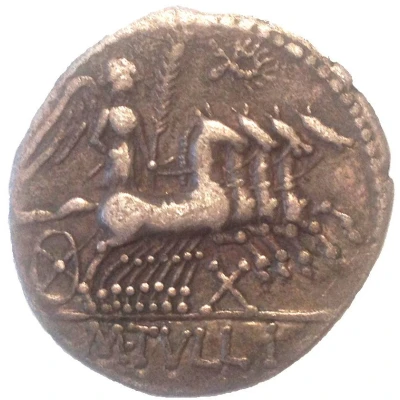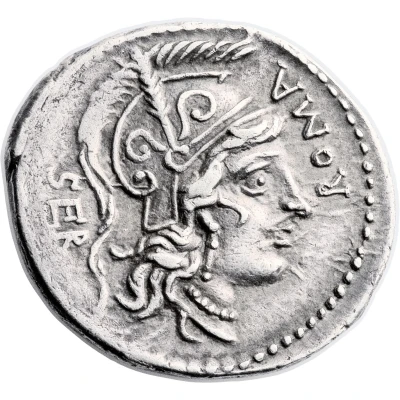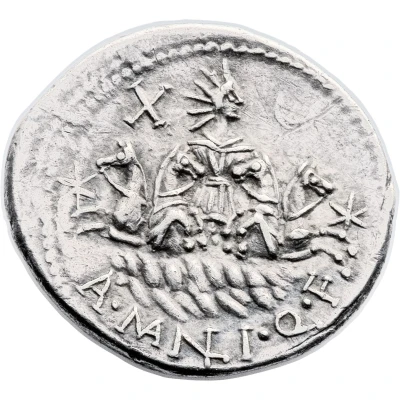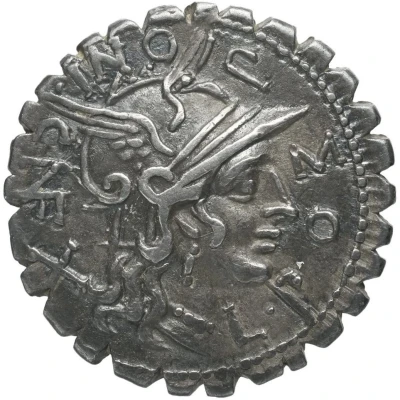
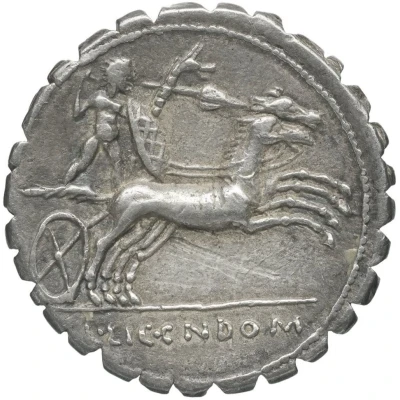

© Bibliothèque nationale de France / Gallica
Denarius serratus Pomponia: Lucius Pomponius; L•POMPONI•CNF / L•LIC•CN•DOM 118 BC
118 BC year| Silver (.950) | 3.64 g | 19 mm |
| Issuer | Rome › Roman Republic (509 BC - 27 BC) |
|---|---|
| Period | Republic (509 BC - 27 BC) |
| Type | Circulating commemorative coin |
| Year | 118 BC |
| Value | Denarius (1) |
| Currency | Denarius of 10 Asses (221 – 141 BC) |
| Composition | Silver (.950) |
| Weight | 3.64 g |
| Diameter | 19 mm |
| Shape | Round (irregular) |
| Technique | Hammered |
| Orientation | Variable alignment ↺ |
| Demonetized | Yes |
| Updated | 2024-10-06 |
| Numista | N#79353 |
|---|---|
| Rarity index | 90% |
Reverse
Naked Gallic warrior (perhaps Bituitus, King of the Arverni) in biga galloping right; holding shield, carnyx and reins in left hand and hurling spear with right hand.
Two moneyer marks following each other in exergue.
Border of dots.
Script: Latin
Lettering: L•LIC•CN•DOM
Translation:
Lucius Licinius (Lucius Licinius [Crassus])
Cnæus Domitius (Gnaeus Domitius [Cn. f. Cn. n. Ahenobarbus])
Edge
Serrated
Comment
This coin bears three moneyer marks from three different gens. RSC lists this coin under the gens Pomponia.For this type, Crawford lists an estimate of 103 obverse dies and 129 reverse dies.
This denarius commemorates the collapse of the Empire of the Arverni in 121 BC and the defeat of its king, Bituitus. The Narbonensis province was created to defend the Provincia and the interests of Rome in Gallia Transalpina. The city of Narbonne (Narbo Martius) was founded in 118 BC. Five moneyers, under the leadership of Lucius Licinius Crassus and Cnæus Domitius Ahenobarbus, struck denarius "serrati" (made to avoid counterfeits): Lucius Cosconius, Gaius Malleolus, Lucius Pomponius, Lucius Porcius Licinius and Marcus Aurelius Scaurus. Zehnacker thinks, like Sydenham, that these coins have been struck between 112 and 109 BC. Crawford rather goes for 118 BC, the very year of the founding of the new city. Zehnacker (in Moneta, p. 849) observes that: "The reverses present a greater unity, eventually due to the engraving of a special prototype, Bituitus on his chariot". Moreover the king is depicted threatening, charging, thus giving an impression of danger that strengthens the role of his victor Domitius. This reverse is to be reconciled with that of Lucius Hostilius Saserna, which will be used seventy years later (48 BC), presenting Vercingetorix in the same combative attitude (RCV#418).
The gens Pomponia was a plebeian family at Rome throughout the period of the Republic and into imperial times. The first of the gens to achieve prominence was Marcus Pomponius, tribune of the plebs in 449 BC; the first who obtained the consulship was Manius Pomponius Matho in 233 BC.
The gens Licinia was a celebrated plebeian family at Rome, which appears from the earliest days of the Republic until Imperial times, and which eventually obtained the imperial dignity. The first of the gens to obtain the consulship was Gaius Licinius Calvus Stolo, who, as tribune of the plebs from 376 to 367 BC, prevented the election of any of the annual magistrates, until the patricians acquiesced to the passage of the lex Licinia Sextia. This law, named for Licinius and his colleague, Lucius Sextius, opened the consulship for the first time to the plebeians. Licinius himself was subsequently elected consul in 364 and 361 BC, and from this time, the Licinii became one of the most illustrious gentes in the Republic.
The gens Domitia was a plebeian family at Rome. The first of the gens to achieve prominence was Gnaeus Domitius Calvinus, consul in 332 BC. The family produced several distinguished generals, and towards the end of the Republic, the Domitii were looked upon as one of the most illustrious gentes.
Interesting fact
One interesting fact about this coin is that it features the image of a serrated edge, which was a unique feature for coins during that time period. The serrations were added to the edges of the coin to prevent counterfeiting and to make it easier for people to tell genuine coins from fake ones. This feature was particularly important during the Roman Republic, as there were many instances of counterfeit coins being produced and circulated. The inclusion of serrations on the Denarius serratus coin shows the attention to detail and the efforts taken by the Roman government to ensure the authenticity and value of their currency.

